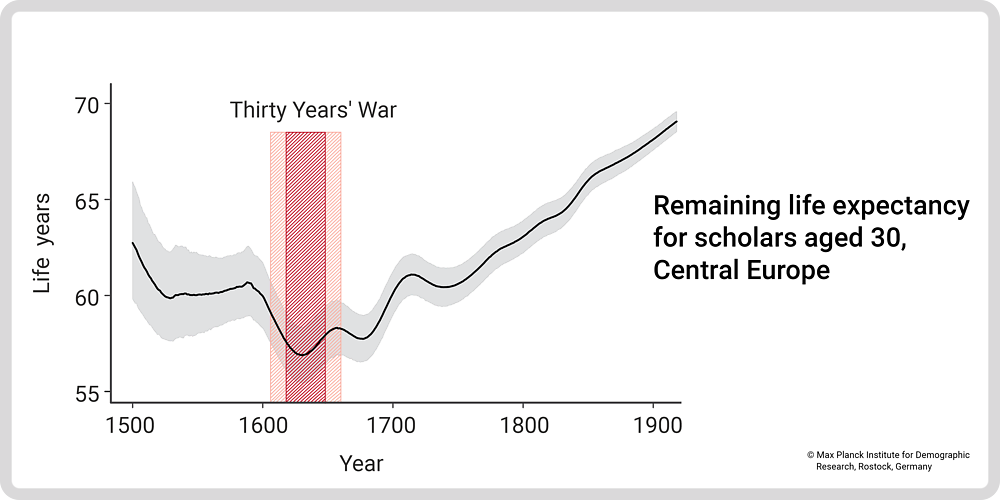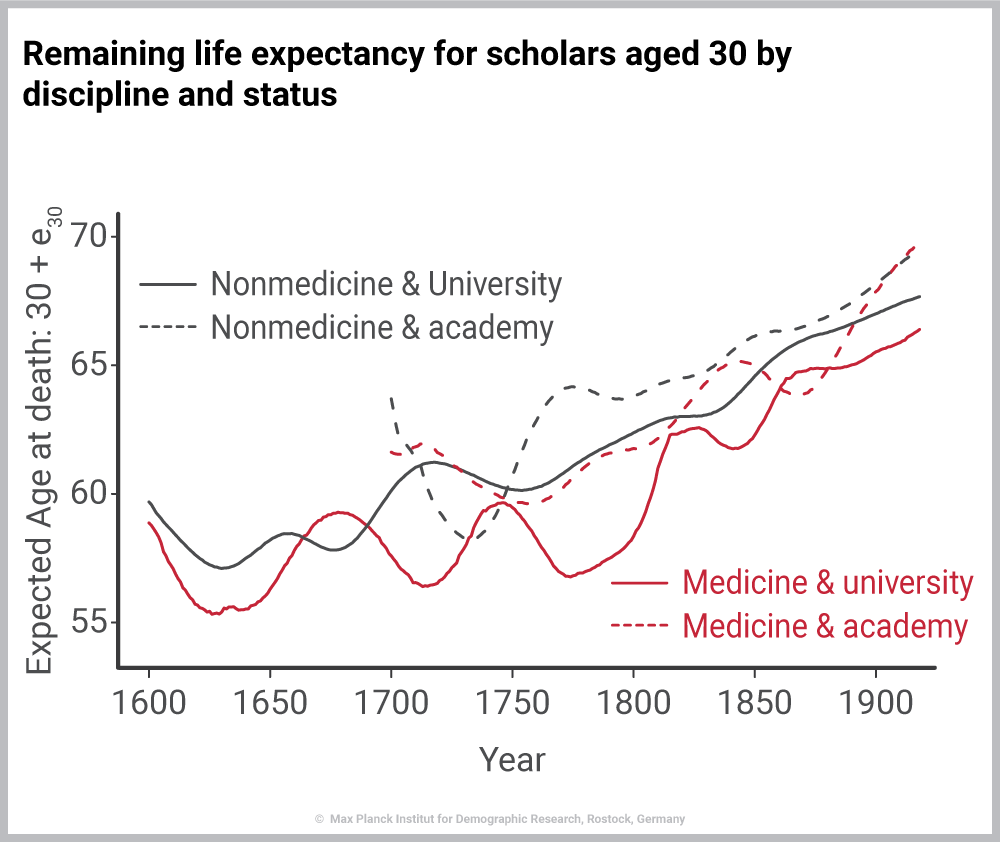September 03, 2021 | Press Release
Life Expectancy: Steady Increase Since 1750

Study on the life span of scholars reveals effects of wars and disease. © iStockphoto.com/aluxum
Scholars in the Holy Roman Empire could expect to live for about 60 years as early as at the close of the Middle Ages. But their life expectancy did not climb any further right into the 18th century. Just the contrary, the Thirty Years' War brought a severe mortality crisis.
(The following text is based on the original paper Leaders and laggards in life expectancy among European scholars from the sixteenth to the early twentieth century by MPIDR researcher Robert Stelter. A German version with minor changes has also been published in the issue 02/2021 of the demographic quarterly Demografische Forschung Aus Erster Hand.)
Today we know quite precisely how life expectancy develops in different countries and regions. But as to the past, the data are often incomplete: How long did people live 500 years ago? And what factors had a positive or negative effect on life expectancy?
Robert Stelter and Mikko Myrskylä of the Max Planck Institute for Demographic Research and David de la Croix of the Université catholique de Louvain put in considerable efforts to shed some more light on the matter: The researchers gathered data from digital and analog sources on more than 30,000 scholars born in the Middle Ages up to 1900 and who were active at universities or academies of sciences. They limited their investigation to the Holy Roman Empire in its borders of 1648 and to the Netherlands.
With the data they collected on the year of birth, the year of first entry into a science academy or university, and the year of death, Stelter and his colleagues were able to calculate the scholars‘ life expectancy. Many of them were 30 years old or younger at first appointment, the researchers thus calculated the remaining life expectancy at age 30. Additionally, the data were smoothed and averaged over 25 years.

The hatched area shows the time period at which the Thirty Years' War might have had affected life expectancy.
Download Figure (PNG File, 685 kB)
Around 400-years of life expectancy development were drawn from the data; these can be roughly divided into three phases (see Fig. 1). Life expectancy stagnated from year 1500 up to the early 18th century, with a decline at the onset of the 16th century mainly due to selection effects in the data. Complete data are often available for especially well-known scholars only; these had a life expectancy that was comparatively high.
Life expectancy generally stagnated prior to the 18th century, but it was by no means stable. The remaining life expectancy of the scholars at age 30, for example, declined by several years at the start of the 17th century: It fell from over 30 to under 27 years, i.e., from a total life expectancy of over 60 to 57 years. Stelter, de la Croix, and Myrskylä assume that this development could be largely due to the Thirty Years' War, along with the epidemics and famines that accompanied it. The many plague outbreaks during this period are well documented.
Life expectancy starts to increase eventually and steadily from the mid-18th century onward. By 1918, the average remaining lifespan of the scholars had jumped remarkably by 7.5 years to a total of 69 years.

Medical professionals had a lower life expectancy than scholars in other scientific disciplines, possibly due to frequent exposure to pathogens. © MPIDR
Download Figure (PNG File, 68 kB)
Next to the general development in life expectancy, the authors show that mortality was not necessarily the same for all scholars (see Fig. 2): Members of the science academies, for example, were an educated elite within elites. When life expectancy began to increase in the 18th century, they enjoyed a mortality advantage over those scholars who were active at university "only". Thus, social status might have had an influence on average lifespan even more than 300 years ago.
The scholars‘ scientific disciplines show differences, too. For example, the average lifespan of medical professionals – both in academies and universities – is generally much lower than that of scholars of other disciplines. This disadvantage may have resulted from the combination of frequent exposure to pathogens and the lack of medical knowledge about germs at that time. Only with the spread of germ theory in the recent past did the risk of infection decline, and medical professionals caught up with scholars in other disciplines in terms of life expectancy.
Naturally, all of these statements are limited to a fairly well-defined but selective population group: Not only did scholars enjoy a special social status, they were also almost exclusively men and generally lived in the city in the period studied. Nevertheless, the study is an impressive demonstration of how major wars and pandemics can affect lifespan and that life expectancy began to increase as early as in the mid-18th century – and thus even before the onset of industrialization in Central Europe.
Original Publication
Stelter, R., de la Croix, D., Myrskylä, M.: Leaders and laggards in life expectancy among European scholars from the sixteenth to the early twentieth century. Demography 58(2021)1, 111–135. DOI: 10.1215/00703370-8938107